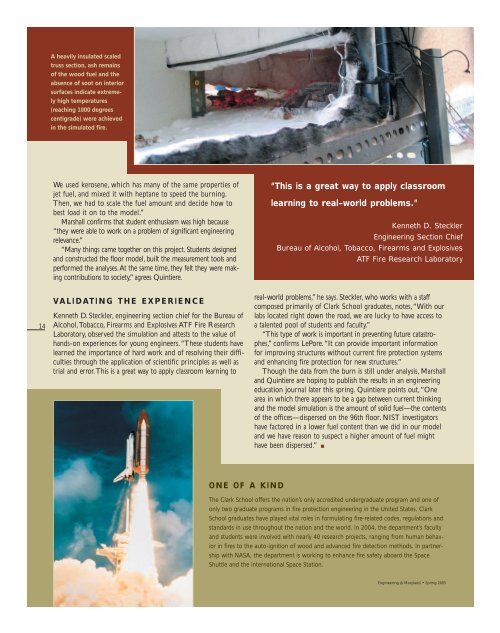Spring 2005 - A. James Clark School of Engineering - University of ...
Spring 2005 - A. James Clark School of Engineering - University of ...
Spring 2005 - A. James Clark School of Engineering - University of ...
Create successful ePaper yourself
Turn your PDF publications into a flip-book with our unique Google optimized e-Paper software.
14<br />
A heavily insulated scaled<br />
truss section, ash remains<br />
<strong>of</strong> the wood fuel and the<br />
absence <strong>of</strong> soot on interior<br />
surfaces indicate extremely<br />
high temperatures<br />
(reaching 1000 degrees<br />
centigrade) were achieved<br />
in the simulated fire.<br />
We used kerosene, which has many <strong>of</strong> the same properties <strong>of</strong><br />
jet fuel, and mixed it with heptane to speed the burning.<br />
Then, we had to scale the fuel amount and decide how to<br />
best load it on to the model.”<br />
Marshall confirms that student enthusiasm was high because<br />
“they were able to work on a problem <strong>of</strong> significant engineering<br />
relevance.”<br />
“Many things came together on this project. Students designed<br />
and constructed the floor model, built the measurement tools and<br />
performed the analyses.At the same time, they felt they were making<br />
contributions to society,” agrees Quintiere.<br />
VALIDATING THE EXPERIENCE<br />
Kenneth D. Steckler, engineering section chief for the Bureau <strong>of</strong><br />
Alcohol,Tobacco, Firearms and Explosives ATF Fire Research<br />
Laboratory, observed the simulation and attests to the value <strong>of</strong><br />
hands-on experiences for young engineers.“These students have<br />
learned the importance <strong>of</strong> hard work and <strong>of</strong> resolving their difficulties<br />
through the application <strong>of</strong> scientific principles as well as<br />
trial and error.This is a great way to apply classroom learning to<br />
ONE OF A KIND<br />
“This is a great way to apply classroom<br />
learning to real–world problems.”<br />
Kenneth D. Steckler<br />
<strong>Engineering</strong> Section Chief<br />
Bureau <strong>of</strong> Alcohol, Tobacco, Firearms and Explosives<br />
ATF Fire Research Laboratory<br />
real-world problems,” he says. Steckler, who works with a staff<br />
composed primarily <strong>of</strong> <strong>Clark</strong> <strong>School</strong> graduates, notes,“With our<br />
labs located right down the road, we are lucky to have access to<br />
a talented pool <strong>of</strong> students and faculty.”<br />
“This type <strong>of</strong> work is important in preventing future catastrophes,”<br />
confirms LePore.“It can provide important information<br />
for improving structures without current fire protection systems<br />
and enhancing fire protection for new structures.”<br />
Though the data from the burn is still under analysis, Marshall<br />
and Quintiere are hoping to publish the results in an engineering<br />
education journal later this spring. Quintiere points out,“One<br />
area in which there appears to be a gap between current thinking<br />
and the model simulation is the amount <strong>of</strong> solid fuel—the contents<br />
<strong>of</strong> the <strong>of</strong>fices—dispersed on the 96th floor. NIST investigators<br />
have factored in a lower fuel content than we did in our model<br />
and we have reason to suspect a higher amount <strong>of</strong> fuel might<br />
have been dispersed.” ■<br />
The <strong>Clark</strong> <strong>School</strong> <strong>of</strong>fers the nation’s only accredited undergraduate program and one <strong>of</strong><br />
only two graduate programs in fire protection engineering in the United States. <strong>Clark</strong><br />
<strong>School</strong> graduates have played vital roles in formulating fire-related codes, regulations and<br />
standards in use throughout the nation and the world. In 2004, the department’s faculty<br />
and students were involved with nearly 40 research projects, ranging from human behavior<br />
in fires to the auto-ignition <strong>of</strong> wood and advanced fire detection methods. In partnership<br />
with NASA, the department is working to enhance fire safety aboard the Space<br />
Shuttle and the International Space Station.<br />
<strong>Engineering</strong> @ Maryland ■ <strong>Spring</strong> <strong>2005</strong>





